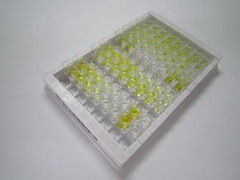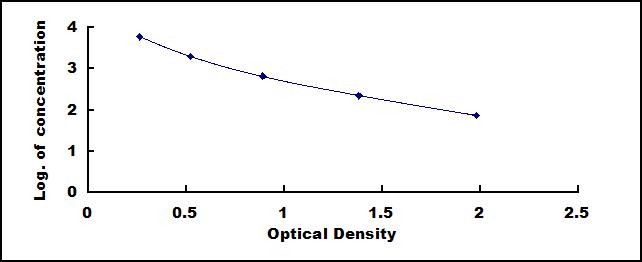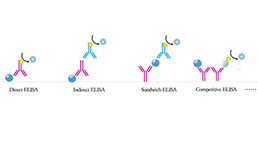Packages (Simulation)

Reagent Preparation

Image (I)
Image (II)
Certificate


ELISA Kit for Reverse Triiodothyronine (rT3)
RT3; r-T3; Reverse T3;(2S)-2-Amino-3-[4-(4-Hydroxy-3,5-Diiodophenoxy)-3-Iodophenyl]propanoic Acid; 3,3',5'-Triiodo-L-thyronine
- Product No.CEC022Ge
- Organism SpeciesPan-species (General) Same name, Different species.
- Sample Typeserum, plasma and other biological fluids
- Test MethodCompetitive Inhibition
- Assay Length2h
- Detection Range74.07-6,000pg/mL
- SensitivityThe minimum detectable dose of this kit is typically less than 27.55pg/mL.
- DownloadInstruction Manual
- UOM 48T96T 96T*5 96T*10 96T*100
- FOB
US$ 571
US$ 816
US$ 3672
US$ 6936
US$ 57120
For more details, please contact local distributors!
Specificity
This assay has high sensitivity and excellent specificity for detection of Reverse Triiodothyronine (rT3).
No significant cross-reactivity or interference between Reverse Triiodothyronine (rT3) and analogues was observed.
Recovery
Matrices listed below were spiked with certain level of Reverse Triiodothyronine (rT3) and the recovery rates were calculated by comparing the measured value to the expected amount of Reverse Triiodothyronine (rT3) in samples.
| Matrix | Recovery range (%) | Average(%) |
| serum(n=5) | 78-103 | 96 |
| EDTA plasma(n=5) | 97-105 | 102 |
| heparin plasma(n=5) | 80-89 | 84 |
Precision
Intra-assay Precision (Precision within an assay): 3 samples with low, middle and high level Reverse Triiodothyronine (rT3) were tested 20 times on one plate, respectively.
Inter-assay Precision (Precision between assays): 3 samples with low, middle and high level Reverse Triiodothyronine (rT3) were tested on 3 different plates, 8 replicates in each plate.
CV(%) = SD/meanX100
Intra-Assay: CV<10%
Inter-Assay: CV<12%
Linearity
The linearity of the kit was assayed by testing samples spiked with appropriate concentration of Reverse Triiodothyronine (rT3) and their serial dilutions. The results were demonstrated by the percentage of calculated concentration to the expected.
| Sample | 1:2 | 1:4 | 1:8 | 1:16 |
| serum(n=5) | 79-101% | 84-93% | 78-94% | 94-102% |
| EDTA plasma(n=5) | 80-88% | 80-101% | 80-101% | 83-91% |
| heparin plasma(n=5) | 93-103% | 82-99% | 81-91% | 78-104% |
Stability
The stability of kit is determined by the loss rate of activity. The loss rate of this kit is less than 5% within the expiration date under appropriate storage condition.
To minimize extra influence on the performance, operation procedures and lab conditions, especially room temperature, air humidity, incubator temperature should be strictly controlled. It is also strongly suggested that the whole assay is performed by the same operator from the beginning to the end.
Reagents and materials provided
| Reagents | Quantity | Reagents | Quantity |
| Pre-coated, ready to use 96-well strip plate | 1 | Plate sealer for 96 wells | 4 |
| Standard | 2 | Standard Diluent | 1×20mL |
| Detection Reagent A | 1×120µL | Assay Diluent A | 1×12mL |
| Detection Reagent B | 1×120µL | Assay Diluent B | 1×12mL |
| TMB Substrate | 1×9mL | Stop Solution | 1×6mL |
| Wash Buffer (30 × concentrate) | 1×20mL | Instruction manual | 1 |
Assay procedure summary
1. Prepare all reagents, samples and standards;
2. Add 50µL standard or sample to each well.
And then add 50µL prepared Detection Reagent A immediately.
Shake and mix. Incubate 1 hour at 37°C;
3. Aspirate and wash 3 times;
4. Add 100µL prepared Detection Reagent B. Incubate 30 minutes at 37°C;
5. Aspirate and wash 5 times;
6. Add 90µL Substrate Solution. Incubate 10-20 minutes at 37°C;
7. Add 50µL Stop Solution. Read at 450 nm immediately.
GIVEAWAYS
INCREMENT SERVICES
| Magazine | Citations |
| J Clin Endocrinol Metab. | N-Acetylcysteine Administration Prevents Nonthyroidal Illness Syndrome in Patients With Acute Myocardial Infarction: A Randomized Clinical Trial Pubmed:25148231 |
| Tierärztliche Hochschule Hannover | Untersuchungen zum Schilddrüsenstoffwechsel der Milchkuh in Abhängigkeit des Laktations-, Reproduktions- und Gesundheitsstatus dissertations:steinhoffl_ws16.pdf |
| Glia. | Inflammation severely alters thyroid hormone signaling in the central nervous system duringexperimental allergic encephalomyelitis in rat: Direct impact on OPCs differentiation failure. pubmed:27404574 |
| Scientific Reports | A thyroid hormone network exists in synovial fibroblasts of rheumatoid arthritis and osteoarthritis patients Pubmed: 31519956 |
| Catalog No. | Related products for research use of Pan-species (General) Organism species | Applications (RESEARCH USE ONLY!) |
| CPC022Ge11 | BSA Conjugated Reverse Triiodothyronine (rT3) | Immunogen; SDS-PAGE; WB. |
| CPC022Ge21 | OVA Conjugated Reverse Triiodothyronine (rT3) | Immunogen; SDS-PAGE; WB. |
| PAC022Ge01 | Polyclonal Antibody to Reverse Triiodothyronine (rT3) | ELISA, CLIA. / IHC-Fr, ICC, IP (predicted). |
| MAC022Ge21 | Monoclonal Antibody to Reverse Triiodothyronine (rT3) | IHC |
| MAC022Ge24 | Monoclonal Antibody to Reverse Triiodothyronine (rT3) | ELISA, CLIA. / IHC-Fr, ICC, IP (predicted). |
| MAC022Ge25 | Monoclonal Antibody to Reverse Triiodothyronine (rT3) | ELISA, CLIA. / IHC-Fr, ICC, IP (predicted). |
| MAC022Ge22 | Monoclonal Antibody to Reverse Triiodothyronine (rT3) | ELISA, CLIA. / IHC-Fr, ICC, IP (predicted). |
| MAC022Ge23 | Monoclonal Antibody to Reverse Triiodothyronine (rT3) | ELISA, CLIA. / IHC-Fr, ICC, IP (predicted). |
| HEC022Ge | High Sensitive ELISA Kit for Reverse Triiodothyronine (rT3) | Enzyme-linked immunosorbent assay for Antigen Detection. |
| CEC022Ge | ELISA Kit for Reverse Triiodothyronine (rT3) | Enzyme-linked immunosorbent assay for Antigen Detection. |
| LMC022Ge | Multiplex Assay Kit for Reverse Triiodothyronine (rT3) ,etc. by FLIA (Flow Luminescence Immunoassay) | FLIA Kit for Antigen Detection. |
| KSC022Ge11 | ELISA Kit DIY Materials for Reverse Triiodothyronine (rT3) | Main materials for "Do It (ELISA Kit) Yourself". |









